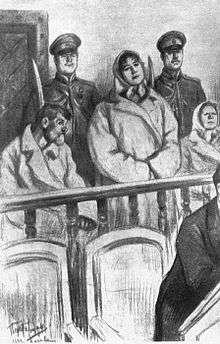Resurrection (novel)
Resurrection (pre-reform Russian: Воскресеніе; post-reform Russian: Воскресение, tr. Voskreséniye), first published in 1899, was the last novel written by Leo Tolstoy. Also translated as The Awakening. The book is the last of his major long fiction works published in his lifetime. Tolstoy intended the novel as an exposition of the injustice of man-made laws and the hypocrisy of the institutionalized church. The novel also explores the economic philosophy of Georgism, of which Tolstoy had become a very strong advocate towards the end of his life, and explains the theory in detail. It was first published serially in the popular weekly magazine Niva in an effort to raise funds for the resettlement of one-third of the Doukhobors from Russia.
.jpg) First US edition | |
| Author | Leo Tolstoy |
|---|---|
| Original title | Воскресеніе |
| Country | Russia |
| Language | Russian |
| Genre | Philosophical novel, political fiction |
| Publisher | First published serially in Niva then Dodd, Mead (US) |
Publication date | 1899 |
Published in English | 1900 |
| Media type | Print (Hardcover, Paperback) and English-language Audio Book |
| Pages | 483 (Oxford World's Classics edition) |
Plot outline
The story is about a nobleman named Dmitri Ivanovich Nekhlyudov, who seeks redemption for a sin committed years earlier. When he was a younger man, at his Aunts' estate, he fell in love with their ward, Katyusha (Katerina Mikhailovna Maslova), who is goddaughter to one Aunt and treated badly by the other. However, after going to the city and becoming corrupted by drink and gambling, he returns two years later to his Aunts' estate and rapes Katyusha, leaving her pregnant. She is then thrown out by his Aunt, and proceeds to face a series of unfortunate and unpleasant events, before she ends up working as a prostitute, going by her surname, Maslova.
Ten years later, Nekhlyudov sits on a jury which sentences the girl, Maslova, to prison in Siberia for murder (poisoning a client who beat her, a crime of which she is innocent). The book narrates his attempts to help her practically, but focuses on his personal mental and moral struggle. He goes to visit her in prison, meets other prisoners, hears their stories, and slowly comes to realize that below his gilded aristocratic world, yet invisible to it, is a much larger world of cruelty, injustice and suffering. Story after story he hears and even sees people chained without cause, beaten without cause, immured in dungeons for life without cause, and a twelve-year-old boy sleeping in a lake of human dung from an overflowing latrine because there is no other place on the prison floor, but clinging in a vain search for love to the leg of the man next to him, until the book achieves the bizarre intensity of a horrific fever dream. He decides to give up his property and pass ownership on to his peasants, leaving them to argue over the different ways in which they can organise the estate, and he follows Katyusha into exile, planning on marrying her. On their long journey into Siberia, she falls in love with another man, and Nekhludov gives his blessing and still chooses to live as part of the penal community, seeking redemption.

Popular and critical reception
The book was eagerly awaited. "How all of us rejoiced," one critic wrote on learning that Tolstoy had decided to make his first fiction in 25 years, not a short novella but a full-length novel. "May God grant that there will be more and more!" It outsold Anna Karenina and War and Peace. Despite its early success, today Resurrection is not as famous as the works that preceded it.[1]
Some writers have said that Resurrection has characters that are one-dimensional and that as a whole the book lacks Tolstoy's earlier attention to detail. By this point, Tolstoy was writing in a style that favored meaning over aesthetic quality.[1]
The book faced much censorship upon publication. The complete and accurate text was not published until 1936. Many publishers printed their own editions because they assumed that Tolstoy had given up all copyrights as he had done with previous books. Instead, Tolstoy retained the copyright and donated all royalties to the Doukhobors, who were Russian pacifists hoping to emigrate to Canada.[1]
It is said of legendary Japanese filmmaker Kenji Mizoguchi that he was of the opinion that "All melodrama is based on Tolstoy's Resurrection".[2]
Adaptations
Operatic adaptations of the novel include the Risurrezione by Italian composer Franco Alfano, Vzkriesenie by Slovak composer Ján Cikker, and Resurrection by American composer Tod Machover. French composer Albert Roussel's 1903 tone poem Résurrection is inspired by the novel.
Additionally, various film adaptations, including a Russian film Katyusha Maslova of director Pyotr Chardynin (1915, the first film role of Natalya Lisenko); a 1944 Italian film Resurrection; a 1949 Chinese film version entitled "蕩婦心" (A Forgotten Woman) starring Bai Guang; a Russian film version directed by Mikhail Shveitser in 1960, with Yevgeny Matveyev, Tamara Semina and Pavel Massalsky, have been made. The best-known film version, however, is Samuel Goldwyn's English-language We Live Again, filmed in 1934 with Fredric March and Anna Sten, and directed by Rouben Mamoulian. The Italian directors Paolo and Vittorio Taviani released their TV film Resurrezione in 2001. The Spanish director Alberto Gonzalez Vergel also released his TV film "Resureccion" in 1966. Kenji Mizoguchi,s film "Straights of love and hate" (1937) was also inspired by "Resurrection".
A 1968 BBC mini-series Resurrection, rebroadcast in the US on Masterpiece Theatre.[3] The Indian movie Barkha Bahar (1973) was based on this novel.
Notes
External links


- Resurrection at Project Gutenberg translated by Louise Maude